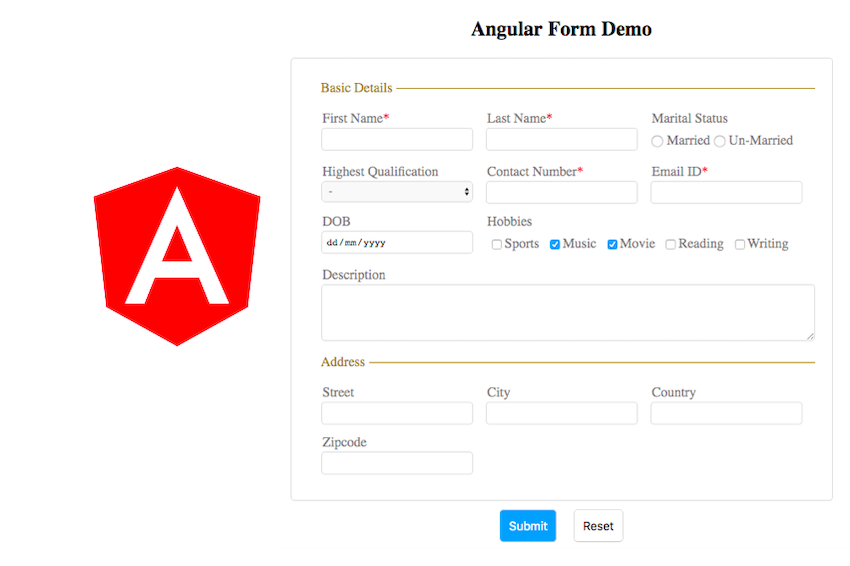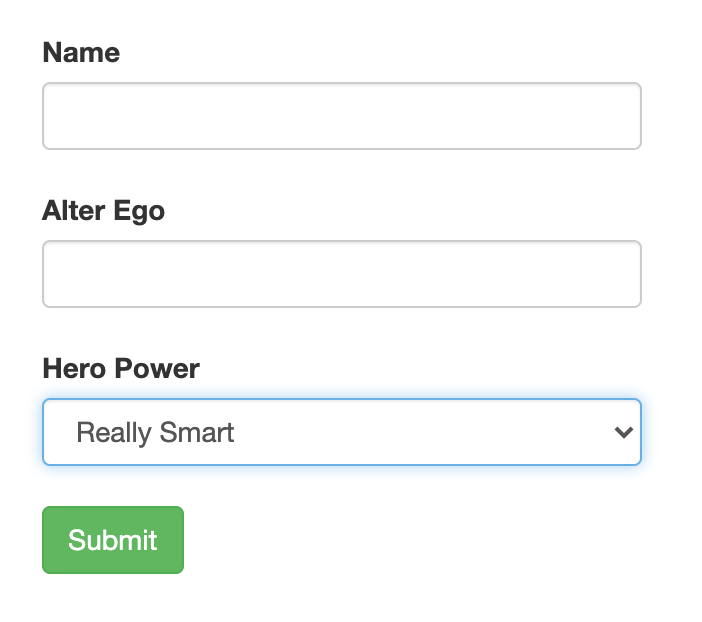在上一篇中提到了 Angular 中的兩種不同的 Form,介紹了他們在使用上以及細節上的不同,接著在本篇中將會著重介紹 Template-driven forms,那就繼續看下去吧。

顧名思義 Template-driven forms 就是一個透過 template 驅動的表單,或者可以說他是基於原生 HTML 所產生出來的表單,在 template 中使用 directive 和 attribute 來為指定的輸入元件進行綁定與驗證,所有的動作都會在 template 中完成,所以 component 只需要很少的設定,這點是和 reactive forms 最大的不同,而 Template-driven forms 具有以下的設置:
ngForm directive 所設置的ngModel directive 設置控制元件所以對於 template-driven forms 的優點在於:
但他的缺點是:
在介紹完 template-driven form 後,接著直接使用一個例子來講解該如何使用 template form 吧,我們的目的再於創建一個 template-driven form,其 template 中的輸入元素綁定到 component 的數據 property,並建立輸入驗證以維護數據的完整性,在這次的例子中我會添加一點樣式讓畫面不會太醜 (![]()
首先要做的就是在 app.module.ts 中從 @angular/form 中將 FormsModule 引入到 app.module 中 metadata 的 imports 中。
import { NgModule } from '@angular/core';
import { BrowserModule } from '@angular/platform-browser';
import { AppRoutingModule } from './app-routing.module';
import { AppComponent } from './app.component';
import { FormsModule } from '@angular/forms';
@NgModule({
declarations: [
AppComponent,
],
imports: [
BrowserModule,
AppRoutingModule,
FormsModule,
],
providers: [],
bootstrap: [AppComponent]
})
export class AppModule { }
接著來建立一個基本的 form 吧,在建立 form 之前先把要 form 的數據模型給定義出來,所以新增一個 class 用於制定數據模型
// hero.ts
export class Hero {
id!: number;
name!: string;
power!: string;
alterEgo?: string;
constructor(id: number, name: string, power: string, alterEgo?: string) {
this.id = id;
this.name = name;
this.power = power;
this.alterEgo = alterEgo;
}
}
建立了名為 Hero 的 class,這樣就可以利用 new 將參數傳入後產生一個固定資料結構的 object,接著使用 Angular CLI 建立一個 component 用於處理 form 的邏輯與顯示
ng generate component hero-form
建立完 component 後,接著在 hero-form.component.ts 中定義一些 form 的細節
import { Component, OnInit } from '@angular/core';
import { Hero } from '../hero'; // (1)
@Component({
selector: 'app-hero-form',
templateUrl: './hero-form.component.html',
styleUrls: ['./hero-form.component.css'],
})
export class HeroFormComponent implements OnInit {
powers = ['Really Smart', 'Super Flexible', 'Super Hot', 'Weather Changer']; // (2)
model = new Hero(18, 'Dr IQ', this.powers[0], 'Chuck Overstreet'); // (3)
submitted = false;
constructor() {}
ngOnInit(): void {}
onSubmit() { // (4)
this.submitted = true;
}
}
定義完 app-hero.component.ts 後,接著將他的 selector 加入到 app.component.html 中
<!-- app.component.html -->
<app-hero-form></app-hero-form>
現在在畫面生應該是空空如也才對,不過這非常正常因為還沒撰寫 hero-form.component 的 view,現在就來把他補上吧,希望在畫面中呈現兩個帶有 <label> 的 <input> 還要有一個 <select> 最後要有一個 <button> 用來點擊 submit。
<!-- hero-form.component.html -->
<div class="form-group">
<label for="name">Name</label>
<input type="text" class="form-control" id="name" required/>
<label for="alterEgo">Alter Ego</label>
<input type="text" class="form-control" id="alterEgo" required/>
<label for="power">Hero Power</label>
<select class="form-control" id="power" required>
<option *ngFor="let pow of powers" [value]="pow">{{ pow }}</option>
</select>
<button type="submit" class="btn btn-success">Submit</button>
</div>

在畫面中會看到這樣的畫面,因為我有加一些 CSS 的樣式,所以這邊可以發揮你的 CSS 功力看是要做的跟我一樣還是做一個屬於你自己的,不過主要還是要介紹 template form 所以就不多做介紹。
在完成基本的 form 畫面後,下一步要使用 雙向綁定 ( Two-way binding ) 將 template 中的輸入元素綁定到 component 中對應的 property,以便將使用者輸入的值更新綁定的 property,也讓使用程式更改的 property 的值可以呈現在畫面中。
FormsModule 中聲明的 ngModel directive 可以讓 template-driven form 中的控制元件綁定到數據模型中的 property,當使用 Two-way binding 綁定 [(ngModel)] 後, Angualr 就可以跟蹤控制元件的值和使用者交互,這可以讓畫面與表單模型保持同步。
首先先更改 hero-form.component.html 中的內容
<!-- hero-form.component.html -->
<div class="form-group">
<label for="name">Name</label>
<input
type="text"
class="form-control"
id="name"
[(ngModel)]="model.name"
name="name"
required
#name="ngModel"
/>
<label for="alterEgo">Alter Ego</label>
<input
type="text"
class="form-control"
id="alterEgo"
[(ngModel)]="model.alterEgo"
name="alterEgo"
required
#alterEgo="ngModel"
/>
<label for="power">Hero Power</label>
<select class="form-control" id="power" [(ngModel)]="model.power" name="power">
<option *ngFor="let pow of powers" [value]="pow">{{ pow }}</option>
</select>
<button type="submit" class="btn btn-success">Submit</button>
</div>
在 Name 和 Alter Ego 兩個 <label> 下面的 <input> 利用 [(ngModel)] 綁定 component 中的 property,這邊要注意的是當你使用了 [(ngModel)] 綁定 property 後,需要定義他的 name 不然會報錯喔!
綁定完每一個輸入元素後接著來對整個 Form 進行綁定,在導入 FormsModule 時 Angular 會自動創建一個 NgForm directive 並將其附加到 template 中的 <form> 上面(因為 NgForm 具有匹配 <form> 的 select ),所以要訪問 NgForm 和整個表單狀態,需要聲明一個 template 引用變量。
<!-- hero-form.component.html -->
{{ model | json }}
<form #heroForm="ngForm">
<div class="form-group">
<label for="name">Name</label>
<input
type="text"
class="form-control"
id="name"
[(ngModel)]="model.name"
name="name"
required
#name="ngModel"
/>
<label for="alterEgo">Alter Ego</label>
<input
type="text"
class="form-control"
id="alterEgo"
[(ngModel)]="model.alterEgo"
name="alterEgo"
required
name="alterEgo"
/>
<label for="power">Hero Power</label>
<select
class="form-control"
id="power"
[(ngModel)]="model.power"
name="power"
>
<option *ngFor="let pow of powers" [value]="pow">{{ pow }}</option>
</select>
<button type="submit" class="btn btn-success">Submit</button>
</div>
</form>
使用 <form> 將之前寫的表單包起來並使用 template variable 設定 #heroForm,而 heroForm 這個變量現在是對控制整個表單的 NgForm directive 實例的 reference。
而在整個 form 上面添加了 {{ model | json }} 用於觀看 component property 的變化,可以在畫面中的輸入框更改名稱或選擇其他的 power 來看看 component 中的 property 會不會跟著改變。
接著要來介紹 NgModel directive 的跟蹤控制元件的狀態,他會告訴你使用者是否觸碰了控制元件、值是否被更改了或是輸入的值是否無效,Angular 在控制元件上設置了特殊的 CSS Class 來反映他的狀況,如下表所示
State | Class is true | Class if false
------------- | -------------
控制元件是否被訪問 | ng-touched | ng-untouched
控制元件的值是否被更改 | ng-dirty | ng-pristine
控制元件的值是否有效 | ng-valid | ng-invalid
此外 Angular 再提交時將 ng-submitted CSS Class 應該要用於 <form>,所以不放在上面一起介紹。
要查看 Angular 如何添加和刪除 CSS Class,可以打開瀏覽器的開發人員工具並檢查英雄姓名的 <input>。
<input> 綁定的 CSS Class 發生更改<input> 中執行以下操作會更改成不同的 CSS Class
<input> 的話,代表他是未受影響的、原始且有效的。<input> 後在點擊外部(不更改內容),現在已經訪問了控制元件,所以 CSS Class 從 ng-untouched 變為 ng-touched。<input> 的內容加入一個斜槓( \ ),他會變成 ng-touched 和 ng-dirty。<input> 的內容這會使這個控制元件的值變為無效,因此會從 ng-valid 變為 ng-invalid。可以利用 ng-valid 和 ng-invalid 來處理當使用者填入非有效內容時會發生什麼事,當輸入無效時可以在輸入框下方顯示警告的畫面,也可以在警告的畫面中填入提醒或範例,可以在 Name 的後面加上一個 <div> 並利用 [hidded] 來控制是否顯示僅告訊息
<label for="name">Name</label>
<input
type="text"
class="form-control"
id="name"
[(ngModel)]="model.name"
name="name"
required
#name="ngModel"
/>
<div [hidden]="name.valid || name.pristine" class="alert alert-danger">
Name is required
</div>
當 name 的值是 valid 和 pristine 的時候會將這個警告區域隱藏,而當輸入值為 invalid 實則會顯示

在使用者填寫完表單後應該要有一個功能是提交使用者所寫的內容,以上面的例子來說就是下方的 submit 按鈕,但是目前還沒對他進行任何處理所以點了也沒反應,接著要來對這個按鈕進行更改
首先在 <form> 中添加一個 event binding,將 (ngSubmit) 綁定上去
<form (ngSubmit)="onSubmit()" #heroForm="ngForm">
接著使用 template variable #heroForm 來當作 submit 按鈕是否可以被點擊(是否所有內容都 valid),並將他的 type 改為 submit
<button type="submit" class="btn btn-success" [disabled]="!heroForm.form.valid">Submit</button>
在 hero-form.component.ts 中更改 onSubmit method
import { Component, ViewChild } from '@angular/core'; // (1)
import { NgForm } from '@angular/forms';
import { Hero } from '../hero';
@Component({
selector: 'app-hero-form',
templateUrl: './hero-form.component.html',
styleUrls: ['./hero-form.component.css'],
})
export class HeroFormComponent {
@ViewChild('heroForm', { static: true }) heroForm!: NgForm; // (2)
powers = ['Really Smart', 'Super Flexible', 'Super Hot', 'Weather Changer'];
model = new Hero(18, 'Dr IQ', this.powers[0], 'Chuck Overstreet');
submitted = false;
constructor() {}
onSubmit() {
console.log(this.heroForm.value); // (3)
this.submitted = true;
}
}
@angular/core 中引入 ViewChild
heroForm

本章中介紹了如何建立一個 template-driven form,可以對數據進行修改、驗證等等,使用 [(NgModel)] 雙向綁定 component 中的 property,使用 ngModel 中的 valid 來判斷使用者輸入的內容是否符合規定,至於 submit 按鈕的 event binding 並不像之前的例子一樣綁定在 <button> 上,而是要將 (ngSumbit) 綁定在 <form> 上,這樣才可以獲得整個 form 的內容,而在 component 中要獲得表單的內容需要使用 @ViewChild 綁定 <form> 上的 template variable。
下一篇將要介紹 Angualr 中的另一種 form,Reactive forms 他相較於 template form 來說會複雜一點,但是比較有彈性且比較可測試性,對於大型的 form 來說是非常好用且方便的,詳細的內容就明天再講解吧,那麼明天見吧。
